
The dollar is getting cheaper against the euro, the yen and the pound sterling in trading on Thursday before the release of inflation data for December in the United States.
The ICE-calculated index showing the dollar’s dynamics against six currencies (euro, Swiss franc, yen, Canadian dollar, pound sterling and Swedish krona) lost 0.15% in trading, while the broader WSJ Dollar Index lost 0.22%.
The euro/dollar pair is trading at $1.0775, compared to $1.0757 at the close of the previous session, as of 7:40 a.m. Ksk.
The U.S. currency pair with the yen dropped to 131.47 yen, compared to 132.49 yen in previous trading.
The exchange rate of the pound to the dollar rose to $1.2167 against $1.2149 the day before.
Thursday traders’ attention was fixed on the report of the U.S. Department of Labor on the last month’s dynamics of consumer prices in the country. The consensus forecast from experts polled by Trading Economics suggests that inflation in the U.S. slowed to 6.5% in December from 7.1% in November. The data will be released at 4:30 p.m. Moscow time.
Signals of weakening consumer price growth in the U.S. speak in favor of a further slowdown in the Federal Reserve’s (Fed’s) tightening of monetary policy.
Meanwhile, U.S. central bankers aren’t in a hurry to abandon their hawkish stance: earlier this week, Mary Daley, president of the Federal Reserve Bank (Fed) of San Francisco, said in an interview with The Wall Street Journal that she thinks the Fed will have to raise the rate above 5% to achieve its inflation target.
Her colleague at the Atlanta Fed, Rafael Bostic, also confirmed his earlier opinion that the rate would be raised above 5%. Currently, its range is 4.25-4.5%.
The dollar/yuan pair exchange rate fell to 6.7565 yuan on Thursday against 6.7705 yuan at the close of the previous session.
China’s inflation accelerated to 1.8% year on year in December from 1.6% in November following a rise in food prices.
EURO, pound, U.S. dollar, yen
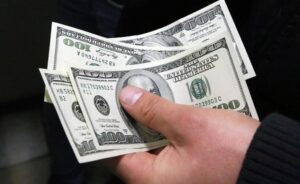
The U.S. dollar is declining against the euro and the Japanese yen and is rising against the pound sterling in trading on Tuesday.
The ICE-calculated index, which shows the dollar’s movement against six currencies (euro, Swiss franc, yen, Canadian dollar, pound sterling and Swedish krona), is up 0.17% in trading, while the broader WSJ Dollar Index is losing 0.05%.
The euro/dollar pair is trading at $1.0743 as of 7:34 a.m. Ksk on Tuesday, up from $1.0735 at the close of the previous session.
The U.S. currency pair with the yen dropped to 131.74 yen, compared to 131.89 yen in previous trading.
Pound to dollar exchange rate fell to $1.2173 against $1.2185 on Monday.
Investors are inclined to believe that the U.S. Federal Reserve (Fed) may be close to completing its tightening of monetary policy, despite hawkish statements from the regulator’s management.
Mary Daley, head of the Federal Reserve Bank (Fed) of San Francisco, said she believes the U.S. central bank will have to raise the rate above 5% to fight inflation.
Her colleague at the Atlanta Fed, Rafael Bostic, also confirmed his earlier opinion that the rate would be raised to more than 5%. Currently, its range is 4.25-4.5%.
Meanwhile, the easing of anti-coronaval restrictions in China is spurring demand for risky assets.
The Chinese yuan is up 0.1% at 6.7640 yuan/$1 from 6.7725 yuan/$1 the day before.
The ICE-calculated index showing the dollar’s dynamics against six currencies (euro, Swiss franc, yen, Canadian dollar, pound sterling and Swedish krona) is up 0.17% in trading, while the broader WSJ Dollar Index is losing 0.05%.
The euro/dollar pair is trading at $1.0743 as of 7:34 a.m. Ksk on Tuesday, up from $1.0735 at the close of the previous session.
The U.S. currency pair with the yen dropped to 131.74 yen, compared to 131.89 yen in previous trading.
Pound to dollar exchange rate fell to $1.2173 against $1.2185 on Monday.
Investors are inclined to believe that the U.S. Federal Reserve (Fed) may be close to completing its tightening of monetary policy, despite hawkish statements from the regulator’s management.
Mary Daley, head of the Federal Reserve Bank (Fed) of San Francisco, said she believes the U.S. central bank will have to raise the rate above 5% to fight inflation.
Her colleague at the Atlanta Fed, Rafael Bostic, also confirmed his earlier opinion that the rate would be raised to more than 5%. Currently, its range is 4.25-4.5%.
Meanwhile, the easing of anti-coronaval restrictions in China is spurring demand for risky assets.
The Chinese yuan is up 0.1% at 6.7640 yuan/$1 from 6.7725 yuan/$1 the day before.
EURO, pound, U.S. dollar, yen
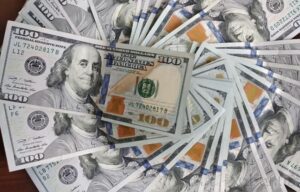
The U.S. dollar fell against the euro, yen and pound sterling on Monday as fresh signs of a slowdown in U.S. inflation boosted traders’ hopes that the Federal Reserve will be able to halt the cycle of interest rate hikes earlier than expected.
The ICE-calculated index, which shows the dynamics of the dollar against six currencies (euro, Swiss franc, yen, Canadian dollar, pound sterling and Swedish krona), loses 0.29% during trading, the broader WSJ Dollar Index – 0.39%.
As of 7:55 a.m. Monday, the EUR/USD pair is trading at $1.0684, compared to $1.0644 at the close of the previous session.
The value of the American currency against the yen fell to 131.83 yen compared to 132.11 yen in the previous trade.
The pound to dollar rose to $1.2152 against $1.2093 on Friday.
Stats on the US labor market, released last Friday, showed the smallest increase in the number of jobs in the US economy in December since December 2020 – by 223 thousand. Unemployment in the States decreased to 3.5% from 3.6% in November.
At the same time, the average hourly wages in the private sector in December increased by 0.3% compared to the previous month and by 4.6% in annual terms. The growth rate slowed from 0.4% and 4.8% respectively in November and was weaker than analysts’ expectations (0.4% and 5%).
A member of the Board of Governors of the Federal Reserve, Lisa Cook, however, is not too optimistic about the prospects for a slowdown in inflation, according to Market Watch.
“Despite a number of encouraging signals we’ve seen recently, inflation remains excessively high, and that’s a serious concern,” she said during a speech last Friday at the American Economic Association event in New Orleans.
At the same event, the President of the Federal Reserve Bank of Atlanta, Rafael Bostic, said that he sees the need to raise the Fed rate to 5.25%.
“We still have a lot of work to do,” Bostick said.
In December, the American Central Bank increased the interest rate by 50 basis points to 4.25-4.5%
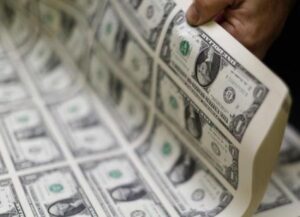
The U.S. dollar is stable against the euro in trading on Thursday, getting cheaper against the yen, despite the hawkish tone of the Federal Reserve’s (Fed) December meeting minutes published the day before.
The ICE-calculated index showing the dollar’s performance against six currencies (euro, Swiss franc, yen, Canadian dollar, pound sterling and Swedish krona) is stable in trading, while the broader WSJ Dollar Index is adding 0.01%.
As of 8:00 a.m. Ksk on Thursday, the euro/dollar pair is trading at $1.0610, up from $1.0606 at the close of the previous session.
The value of the U.S. currency in a pair with the yen dropped to 132.47 yen, compared to 132.63 yen in previous trading.
The pound to dollar exchange rate fell to $1.2040 against $1.2054 the day before.
Minutes of the December meeting of the Federal Reserve showed that none of the Fed’s leaders believes it is reasonable to reduce the benchmark interest rate in the beginning of the year, as the financial markets expect.
Meeting participants generally believed that “maintaining restrictive monetary policy for an extended period until inflation clearly moves toward 2 percent would be justified,” the minutes said.
At that, the U.S. Central Bank confirmed its desire to achieve slowdown of inflation without excessive weakening of economic activity, Bloomberg agency notes.
Heads of Fed named two main risks as preservation of the raised inflation during longer, than it is expected, interval, and also the fact that the cumulative effect from raising rates can appear with some delay and lead to excessive toughening of financial conditions.
In December the Fed raised the rate by 50 basis points (bps) – to 4,25-4,5% per annum, while at the previous four meetings the rate was increased by 75 bps. At the same time, Fed Chairman Jerome Powell said the U.S. central bank will raise the rate until it meets its inflation targets.
Investors are waiting for the U.S. labor market data for December, which will be released on Friday at 15:30 ksec. Experts polled by Trading Economics on average expect the number of jobs in the U.S. to rise by 200,000 last month and unemployment to remain at 3.7%.
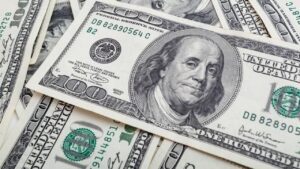
The ICE-calculated index showing the dollar’s dynamics against six currencies (euro, Swiss franc, yen, Canadian dollar, pound and Swedish krone) is losing 0.03% in trading, while the broader WSJ Dollar Index – 0.24%.
Traders are waiting for the publication of the minutes of the Federal Reserve’s (Fed) December meeting, expecting to see signals in it that the U.S. central bank is ready to soften plans to further raise the benchmark interest rate amid weakening global economic activity, Market Watch notes.
The Fed raised the rate by 50 basis points (bps) to 4.25-4.5% per annum in December, while at the previous four meetings it had increased by 75 bps. At the same time, Fed Chairman Jerome Powell said that the U.S. Central Bank will raise the rate until it reaches its inflation targets.
“While the Fed plans to keep rates high longer than previously expected, markets continue to resist, still expecting policy easing,” High-Frequency Economics experts Rubila Farooqui and John Sylvia said in a review. – We don’t expect the Fed to move to a rate cut this year.”
The minutes of the Fed’s December meeting will be released Wednesday at 9:00 p.m. Q.
As of 8:05 a.m. QE Wednesday, the euro/dollar pair is trading at $1.0573, up from $1.0550 at the close of the previous session. The pound/dollar exchange rate is at $1.1986 against $1.1967 the day before.
The U.S. currency pair with the yen dropped to 130.8 yen from 131.01 yen during the previous trading session.
The dollar-yuan exchange rate declined during trading to 6.8919 yuan against 6.9151 yuan the day before.
EURO, pound, U.S. dollar, yen
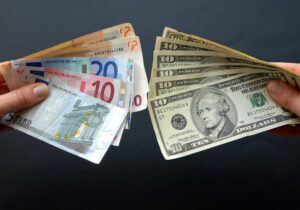
Tuesday the U.S. dollar is almost stable against the European currency and is declining against the yen.
The DXY index, which shows the U.S. dollar value against the six major world currencies, added 0.1% during the session. At the same time, indicator WSJ Dollar, which tracks the movement of the dollar against 16 currencies, dropped by a similar amount.
The euro was trading at $1.0664 against $1.0668 at the end of the previous session.
The value of the single European currency is now around 138.81 yen, compared to 139.46 yen on Monday. The dollar exchange rate is 130.18 yen against 130.74 yen at the end of the previous trading day.
The pound is trading at $1.2069 compared to $1.2048 on the previous trading day and the euro is at £0.8835 compared to £0.8856.
The euro gained 8.8 percent against the dollar in the fourth quarter of 2022, according to Dow Jones Market Data. This was the highest quarterly gain since 2010.
Meanwhile, the DXY index showed a 7.7% drop in October-December, the biggest decline in twelve years. That didn’t stop the indicator from ending 2022 on the plus side: it was up 7.9%, the highest gain since 2015.